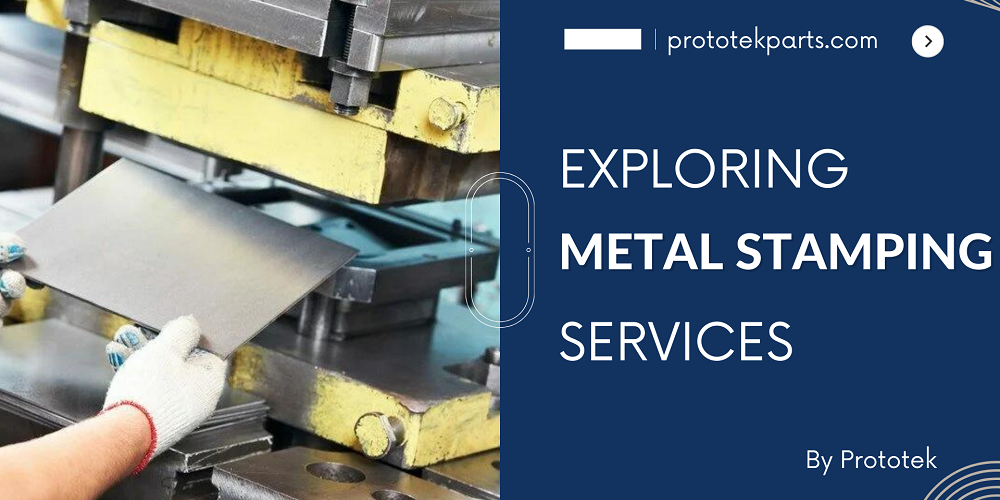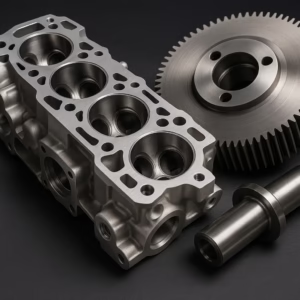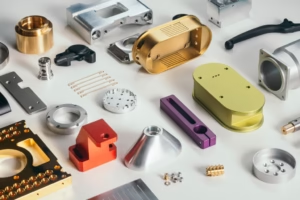Blog Detayları
Exploring Metal Stamping Services: From Concept to Practice
Metal stamping services are pivotal in manufacturing, offering efficient solutions for shaping metal components. This article delves into the intricacies of metal stamping, exploring its significance, applications, and considerations for selecting the right service provider.
What is Metal Stamping?
Metal stamping is a versatile manufacturing process that converts flat metal sheets into various shapes and forms. It involves using presses, dies, and tooling to apply force and manipulate the metal into the desired configuration. The process is commonly employed in automotive, aerospace, electronics, and appliances industries to produce a wide range of components with high precision and efficiency.
Process Overview
The metal stamping process typically begins with a flat sheet or coil of metal, which is fed into a stamping press. The press applies force to the metal using specialized dies, which are machined to the precise shape and dimensions of the desired part. The metal undergoes various operations such as blanking, piercing, forming, and bending as it progresses through the dies. Each operation is carefully controlled to achieve the desired shape and dimensions of the final part.
Blanking and Piercing
Blanking is the process of cutting the metal into a specific shape while piercing involves creating holes or openings in the metal sheet. These operations are typically performed in the initial stages of the stamping process to create the basic outline of the part and prepare it for further forming operations.
Forming and Bending
Forming and bending operations shape the metal into complex geometries and contours. This is achieved by applying controlled pressure to the metal using specialized tooling, which deforms the metal into the desired shape. Forming operations can include drawing, stretching, and deep drawing, depending on the part’s complexity.
Secondary Operations
After the primary forming operations are complete, the stamped parts may undergo secondary operations such as trimming, machining, welding, or assembly to achieve the final desired specifications. These secondary operations are often necessary to remove excess material, refine features, or join multiple components together.
Components of Metal Stamping
Presses
Presses are the primary machines used in metal stamping, applying force to the metal to deform it into the desired shape. Presses can vary in size and capacity, ranging from small mechanical presses to large hydraulic or servo-driven presses capable of exerting thousands of tons of force.
Dies
Dies are specialized tooling components that shape and form metal during stamping. They consist of two main parts: the punch, which applies force to the metal, and the die, which provides the desired shape and support for the metal as it is formed. Depending on the application’s requirements, dies can be made from various materials such as tool steel, carbide, or ceramic.
Tooling
Tooling refers to the various components and accessories used with the presses and dies to facilitate stamping. This includes feeders, grippers, sensors, and safety devices, which help automate and control the stamping operation, ensuring consistent quality and productivity.
Advantages of Metal Stamping
Metal stamping offers several advantages over other manufacturing processes, including:
- High Precision: Metal stamping can achieve tight tolerances and intricate geometries, ensuring consistent quality and accuracy in the finished parts.
- Cost Efficiency: Stamping allows for high-volume production at relatively low per-part costs, making it economical for mass-production applications.
- Versatility: Metal stamping can be used with various metals, including steel, aluminum, copper, and stainless steel, in various thicknesses and grades.
- Speed and Efficiency: Stamping processes can be highly automated, allowing for fast cycle times and high production rates, reducing lead times and time-to-market for new products.
Types of Metal Stamping Services
Single-step Stamping
Single-step stamping, or blanking or shallow drawing, involves completing the entire shaping process in a single stroke of the press. This method suits simpler designs and involves basic operations such as cutting, bending, or forming the metal sheet into the desired shape. Single-step stamping often produces flat or shallow parts with minimal complexity.
Progressive Stamping
On the other hand, progressive stamping is a more advanced technique involving multiple steps or operations performed in sequential dies. As the metal sheet progresses through the press, it undergoes successive operations such as blanking, piercing, forming, and bending in different stages. Each die in the progression performs a specific operation, gradually shaping the metal into the final desired form. Progressive stamping is ideal for producing complex, intricate parts with tight tolerances and high precision.
Custom Stamping
Custom stamping services cater to unique specifications and low-volume orders, offering flexibility and customization options to meet customers’ specific needs. Custom stamping involves working closely with the client to design and manufacture parts tailored to their requirements, often involving prototype development, tooling design, and testing to ensure the final product meets quality standards.
Production Stamping
On the other hand, production stamping focuses on the high-volume manufacturing of standardized parts for mass-production applications. Production stamping services are optimized for efficiency, consistency, and cost-effectiveness, emphasizing high-speed operation and repeatability. These services are typically used for producing large quantities of parts with consistent quality and performance, often using automated equipment and processes to maximize productivity.
Considerations for Choosing the Right Stamping Service
Complexity of Parts
The complexity of the parts to be produced is a key factor in determining the type of stamping service required. For simple designs with minimal features, single-step stamping may be sufficient, while complex parts with intricate geometries may require progressive stamping for precision and accuracy.
Volume and Scale of Production
The volume and scale of production also influence the choice between custom and production stamping services. Custom stamping may be more suitable for low-volume or custom orders, offering flexibility and customization options. Production stamping is often more cost-effective and efficient for high-volume production runs, allowing for large quantities of parts to be produced quickly and consistently.
Quality and Precision Requirements
The quality and precision requirements of the final parts are critical considerations when selecting a stamping service provider. Both single-step and progressive stamping can achieve high levels of accuracy and repeatability, but the specific capabilities and expertise of the service provider may vary. Choosing a provider with a proven track record of delivering quality parts that meet the required specifications and standards is essential.
Lead Times and Turnaround
The lead times and turnaround times for stamping projects can vary depending on the part’s complexity, the production volume, and the service provider’s capabilities. Custom stamping projects may require longer lead times due to the design and tooling development process, while production stamping services offer faster turnaround times for high-volume orders.
Key Considerations for Selecting Prototek Metal Stamping Service Providers
Choosing the right Prototek metal stamping service provider is crucial for the success of your project. Several key considerations should be considered to ensure you select a provider who can meet your requirements and deliver high-quality parts on time and within budget.
Quality and Precision
One of the primary considerations when selecting a Prototek metal stamping service provider is their commitment to quality and precision. Look for providers with a proven track record of consistently delivering parts that meet tight tolerances and specifications. Quality certifications such as ISO 9001 can assure of a provider’s commitment to quality management systems.
Inspection and Quality Control Processes
Inquire about the provider’s inspection and quality control processes to ensure that they have robust procedures in place to monitor and verify the quality of the stamped parts throughout the production process. This may include dimensional inspection, material testing, and visual inspection to identify any defects or deviations from the required specifications.
Advanced Technology and Equipment
Evaluate the provider’s equipment and technology capabilities to ensure they have the resources to handle your project effectively. Look for providers with modern presses, dies, and tooling, as well as advanced technologies such as computer numerical control (CNC) machining, robotic automation, and real-time monitoring systems. These technologies can improve efficiency, accuracy, and productivity, leading to better results and shorter lead times.
Experience and Expertise
Consider the provider’s experience and expertise in metal stamping, particularly in your industry or application. Look for providers with a proven track record of completing projects similar to yours and who have the technical knowledge and capabilities to address any challenges or requirements specific to your project. A provider with experience working with various materials, part geometries, and production volumes will likely be better equipped to meet your needs.
Case Studies and References
Ask for past client case studies, testimonials, and references to assess the provider’s capabilities and reputation. Reviewing examples of past projects can give you insight into the provider’s quality of work, adherence to deadlines, and customer satisfaction levels. Additionally, contacting references directly can provide valuable feedback and insights into their experience working with the provider.
Pricing, Lead Times, and Customer Support
While cost is important, selecting a Prototek metal stamping service provider should not be the sole consideration. Evaluate the provider’s pricing structure in conjunction with their lead times, turnaround times, and level of customer support. A provider who offers competitive pricing, reasonable lead times, and responsive customer support can provide better value in the long run by minimizing delays, addressing any issues promptly, and ensuring a positive overall experience.
Communication and Collaboration
Lastly, consider the provider’s communication and collaboration practices. Choose a responsive, transparent, and proactive provider in their communication, keeping you informed of project progress and any potential issues or delays and providing regular updates throughout the production process. A collaborative approach fosters trust, ensures alignment on project goals and expectations, and facilitates problem-solving and decision-making when needed.
Metal stamping services remain integral to the manufacturing industry, offering efficient, cost-effective solutions for shaping metal components. Selecting the right service provider is paramount, considering factors such as quality, technology, and customer support. As the industry continues to evolve, embracing technological advancements and exploring new materials will drive innovation and growth in metal stamping.
If you have any needs, contact us via email at Lynnyao@prototekparts.com veya telefon edin: +86-0792-86372550
Etiketler:
- metal stamping

























































